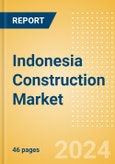The Construction in Indonesia - Key Trends and Opportunities to 2029 (Q1 2025) report provides detailed market analysis, information and insights into the Indonesian construction industry, including:
- The Indonesian construction industry's growth prospects by market, project type and construction activity
- Critical insight into the impact of industry trends and issues, as well as an analysis of key risks and opportunities in the Indonesian construction industry
- Analysis of the mega-project pipeline, focusing on development stages and participants, in addition to listings of major projects in the pipeline
Over the remainder of the forecast period, the Indonesian construction industry is expected to register an average annual growth rate of 6.1% from 2026 to 2029, supported by public and private sector investments in renewable energy, housing, and transport infrastructure sectors. The government is planning to construct 20 nuclear power plants in the country by 2050. The first nuclear power project to be awarded to the American nuclear developer ThorCon, will have a capacity of 500MW and is expected to be worth IDR13 trillion ($868.9 million). It will be developed on Kelasa Island in Bangka Belitung province and expected to be completed by 2028. In November 2024, Philippines based developer and operator of toll roads, Metro Pacific Tollways Corp (MPTC) announced a plan to develop an elevated toll road in Jakarta with an investment of IDR21.4 trillion ($1.4 billion).
Scope
This report provides a comprehensive analysis of the construction industry in Indonesia. It provides:
- Historical (2020-2024) and forecast (2025-2029) valuations of the construction industry in Indonesia, featuring details of key growth drivers.
- Segmentation by sector (commercial, industrial, infrastructure, energy and utilities, institutional and residential) and by sub-sector
- Analysis of the mega-project pipeline, including breakdowns by development stage across all sectors, and projected spending on projects in the existing pipeline.
- Listings of major projects, in addition to details of leading contractors and consultants
Reasons to Buy
- Identify and evaluate market opportunities using our standardized valuation and forecasting methodologies
- Assess market growth potential at a micro-level with over 600 time-series data forecasts
- Understand the latest industry and market trends
- Formulate and validate business strategies using the analyst's critical and actionable insight
- Assess business risks, including cost, regulatory and competitive pressures
- Evaluate competitive risk and success factors
Table of Contents
1 Executive Summary2 Construction Industry: At-a-Glance6 Construction Market Data
3 Context
4 Construction Outlook
5 Key Industry Participants
7 Appendix
List of Tables
List of Figures








